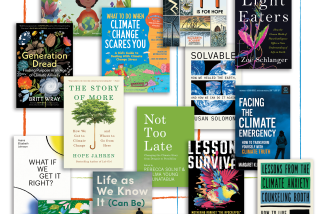‘Water: The Epic Struggle for Wealth, Power, and Civilization’ by Steven Solomon
Water
The Epic Struggle for Wealth, Power and Civilization
Steven Solomon
Harper: 596 pp., $27.99
It’s not news to residents of Southern California that the management of water resources has far-reaching economic and political ramifications, but even they may be surprised by the pivotal role journalist Steven Solomon assigns to water throughout human history. It is “Earth’s most potent agent of change,” Solomon asserts in his sweeping book, which begins with the birth of civilization, is midwifed by large-scale, irrigated agriculture, and closes in our current “age of water scarcity, [when] water’s always paramount, but usually discreet role in world history is visibly taking its place at center stage.”
Solomon’s intelligent, well-informed assessment of the challenges we face today grows naturally from the comprehensive analysis that precedes it in the first three sections: “Water in Ancient History,” “Water and the Ascendancy of the West,” “Water and the Making of the Modern Industrial Society.” The author astutely synthesizes a vast amount of scholarship to spotlight recurring patterns.
One is the enduring tension between two forms of political and economic organization that manage water resources quite differently. The world’s earliest empires, in Mesopotamia and Egypt, were what Solomon calls “hydraulic states”: land-oriented, focused on river irrigation and canals, run by centralized, authoritarian governments. The upstart Greeks by contrast were a “seafaring culture.” When the smaller, nimbler Athenian fleet decimated the Persian navy in history’s first major sea battle, at Salamis in 480 BC, it not only demonstrated that sea power would henceforth be a key component in empire-building; it announced the arrival of “a new model of society,” Solomon avers.
Seafaring culture, he argues, fostered “representative, liberal market democracy.” Foreign trade across the open seas empowered private enterprise and loosened the government’s grip on the economy; societies driven by the profit motive responded more imaginatively to change. A hydraulic state like imperial China excelled in the construction of water infrastructure, such as the 1,100-mile Grand Canal that linked the Yangtze and Yellow rivers in the 7th century, but was inherently inward-looking and conservative: In 1433, for example, an emperor fearful of destabilizing foreign contacts terminated three decades of long-distance sea voyages, squandering China’s “clear naval superiority” at the dawn of the Age of Exploration.
Seafaring Europe seized the initiative. Its weak Christian kingdoms had barely survived the onslaught of Muslim armies in the 8th century, but Islam’s brilliant civilization in Solomon’s view ultimately failed to transcend its origins in the “water-fragile” Arabian peninsula to fully embrace the trans-oceanic sailing that cemented Europe’s domination of global commerce in the 16th century. This dominance only increased in the 18th and 19th centuries, when the steam engine enormously enhanced water’s power-generating abilities and put the British Isles at the heart of the Industrial Revolution. In the 20th century, the world eagerly followed the United States’ lead in building huge, multipurpose dams that provided both hydroelectric power and irrigation that turned deserts into farmland. It seemed that humanity’s potential to control water for its own purposes was virtually unlimited.
Time and again, however, Solomon’s narrative shows that each advance in using water more productively and making it available to more people brings with it explosive increases in population and water consumption. These spark economic growth and a generally higher standard of living, but at some point, often brought on by climate change or “water shocks” like floods, societies find that their ability to exploit water no longer matches the demand they’ve created. Irrigated farmland becomes salinized and unproductive; dams silt up; the supply of drinkable water is no longer sufficient. From the Indus Valley civilization of the second millennium BC to the Mayans 2,000 years later, societies that failed to meet these water challenges have stagnated and collapsed.
The good news is that those that find innovative solutions rise and thrive. Despite an onslaught of sobering statistics in Part 4, “The Age of Scarcity,” Solomon’s overall tone is cautiously optimistic. A grim catalog of the environmental consequences of the Aswan High Dam, warning that “Egypt and its [Nile] basin neighbors are sitting atop a growing demographic and hydrological time bomb,” is placed in counterpoint to an account of Israel’s experiments with high-efficiency drip irrigation and large-scale desalinization of seawater as well as pragmatic back-channel talks with Arab neighbors despite both sides’ confrontational public posturing.
As he has throughout, the author puts his faith in market forces to prompt flexible, appropriate responses. (He is careful to assign a supervisory role to government regulation, provided it’s “clear and predictable.”) Solomon blames artificially low water prices for American agribusinesses’ wasteful irrigation practices, and he approvingly chronicles strong-arm tactics by the U.S. government, which in 2003 literally turned down the tap of Colorado River water that was going to California’s Imperial Valley. That action was done to force the region’s growers to relinquish some of their taxpayer-subsidized water to coastal cities that would pay market rates for it.
The Western world can maintain the preeminence it has gained over centuries of innovative water use, Solomon maintains, if it recognizes and adjusts to the new reality: The global ecosystem cannot be plundered indefinitely, and any new gains in water productivity must be environmentally sustainable. In addition, it must ensure equitable access to water for the world’s poor or face the political consequences likely to be inflicted by a generation of “freshwater Have-Nots,” most living in areas of the world highly susceptible to fundamentalist extremism.
Ranging across several millenniums and dozens of cultures, Solomon offers thought-provoking material on nearly every page, leavening the abundant facts and figures with a judicious sprinkling of colorful anecdotes. His ambitious thematic framework, though, inevitably leads to some oversimplification and a touch of monomania: He seems determined to shoehorn every single thing he knows about water into his hefty text, which is serviceably rather than gracefully written. Compared to the richness of his canvas and the acuity of his insights, however, these are small faults. “Water” enlarges our understanding of how this vital element has shaped our past, providing enough evidence of humanity’s ingenuity in the face of its challenges to offer reasonable hope that we will find ways to use it sanely.
Smith is the author of “Real Life Drama: The Group Theatre and America, 1931-1940.”
More to Read
The biggest entertainment stories
Get our big stories about Hollywood, film, television, music, arts, culture and more right in your inbox as soon as they publish.
You may occasionally receive promotional content from the Los Angeles Times.










